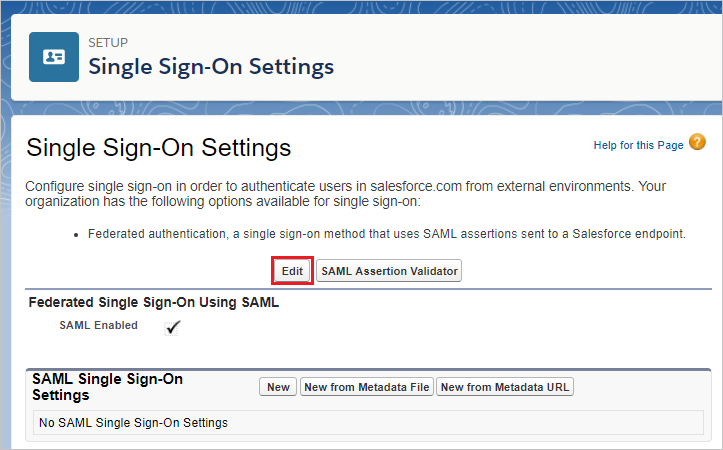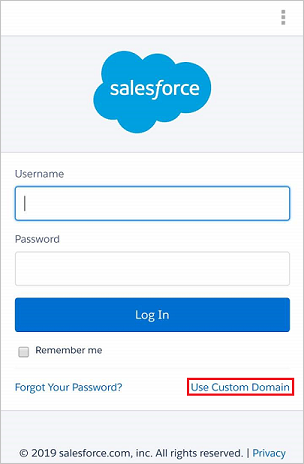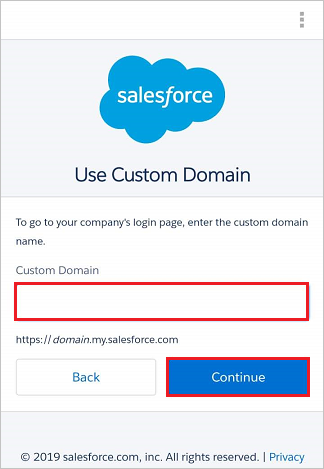Configure Salesforce for Single sign-on
In this article, you learn how to integrate Salesforce with Microsoft Entra ID. When you integrate Salesforce with Microsoft Entra ID, you can:
- Control in Microsoft Entra ID who has access to Salesforce.
- Enable your users to be automatically signed-in to Salesforce with their Microsoft Entra accounts.
- Manage your accounts in one central location.
Prerequisites
The scenario outlined in this article assumes that you already have the following prerequisites:
-
- A Microsoft Entra user account with an active subscription. If you don't already have one, you can Create an account for free.
- One of the following roles:
- Salesforce single sign-on (SSO) enabled subscription.
Scenario description
In this article, you configure and test Microsoft Entra SSO in a test environment.
Salesforce supports SP initiated SSO.
Salesforce supports Automated user provisioning and deprovisioning (recommended).
Salesforce supports Just In Time user provisioning.
Salesforce Mobile application can now be configured with Microsoft Entra ID for enabling SSO. In this article, you configure and test Microsoft Entra SSO in a test environment.
Add Salesforce from the gallery
To configure the integration of Salesforce into Microsoft Entra ID, you need to add Salesforce from the gallery to your list of managed SaaS apps.
- Sign in to the Microsoft Entra admin center as at least a Cloud Application Administrator.
- Browse to Identity > Applications > Enterprise applications > New application.
- In the Add from the gallery section, type Salesforce in the search box.
- Select Salesforce from results panel and then add the app. Wait a few seconds while the app is added to your tenant.
Alternatively, you can also use the Enterprise App Configuration Wizard. In this wizard, you can add an application to your tenant, add users/groups to the app, assign roles, as well as walk through the SSO configuration as well. Learn more about Microsoft 365 wizards.
Configure and test Microsoft Entra SSO for Salesforce
Configure and test Microsoft Entra SSO with Salesforce using a test user called B.Simon. For SSO to work, you need to establish a link relationship between a Microsoft Entra user and the related user in Salesforce.
To configure and test Microsoft Entra SSO with Salesforce, perform the following steps:
- Configure Microsoft Entra SSO - to enable your users to use this feature.
- Create a Microsoft Entra test user - to test Microsoft Entra single sign-on with B.Simon.
- Assign the Microsoft Entra test user - to enable B.Simon to use Microsoft Entra single sign-on.
- Configure Salesforce SSO - to configure the single sign-on settings on application side.
- Create Salesforce test user - to have a counterpart of B.Simon in Salesforce that is linked to the Microsoft Entra representation of user.
- Test SSO - to verify whether the configuration works.
Configure Microsoft Entra SSO
Follow these steps to enable Microsoft Entra SSO.
Sign in to the Microsoft Entra admin center as at least a Cloud Application Administrator.
Browse to Identity > Applications > Enterprise applications > Salesforce > Single sign-on.
On the Select a single sign-on method page, select SAML.
On the Set up single sign-on with SAML page, select the edit/pen icon for Basic SAML Configuration to edit the settings.

On the Basic SAML Configuration section, enter the values for the following fields:
a. In the Identifier textbox, type the value using the following pattern:
Enterprise account:
https://<subdomain>.my.salesforce.comDeveloper account:
https://<subdomain>-dev-ed.my.salesforce.comb. In the Reply URL textbox, type the value using the following pattern:
Enterprise account:
https://<subdomain>.my.salesforce.comDeveloper account:
https://<subdomain>-dev-ed.my.salesforce.comc. In the Sign-on URL textbox, type the value using the following pattern:
Enterprise account:
https://<subdomain>.my.salesforce.comDeveloper account:
https://<subdomain>-dev-ed.my.salesforce.comNote
These values aren't real. Update these values with the actual Identifier, Reply URL and Sign-on URL. Contact Salesforce Client support team to get these values.
On the Set up single sign-on with SAML page, in the SAML Signing Certificate section, find Federation Metadata XML and select Download to download the certificate and save it on your computer.

On the Set up Salesforce section, copy the appropriate URL(s) based on your requirement.

Create a Microsoft Entra test user
In this section, you create a test user called B.Simon.
- Sign in to the Microsoft Entra admin center as at least a User Administrator.
- Browse to Identity > Users > All users.
- Select New user > Create new user, at the top of the screen.
- In the User properties, follow these steps:
- In the Display name field, enter
B.Simon. - In the User principal name field, enter the username@companydomain.extension. For example,
B.Simon@contoso.com. - Select the Show password check box, and then write down the value displayed in the Password box.
- Select Review + create.
- In the Display name field, enter
- Select Create.
Assign the Microsoft Entra test user
In this section, you enable B.Simon to use single sign-on by granting access to Salesforce.
- Sign in to the Microsoft Entra admin center as at least a Cloud Application Administrator.
- Browse to Identity > Applications > Enterprise applications > Salesforce.
- In the app's overview page, select Users and groups.
- Select Add user/group, then select Users and groups in the Add Assignment dialog.
- In the Users and groups dialog, select B.Simon from the Users list, then select the Select button at the bottom of the screen.
- If you expect a role to be assigned to the users, you can select it from the Select a role dropdown. If no role has been set up for this app, you see "Default Access" role selected.
- In the Add Assignment dialog, select the Assign button.
Configure Salesforce SSO
In a different web browser window, sign in to your up Salesforce company site as an administrator
Select on the Setup under settings icon on the top right corner of the page.

Scroll down to the SETTINGS in the navigation pane, select Identity to expand the related section. Then select Single Sign-On Settings.

On the Single Sign-On Settings page, select the Edit button.

Note
If you're unable to enable single sign-on settings for your Salesforce account, you may need to contact Salesforce Client support team.
Select SAML Enabled, and then select Save.

To configure your SAML single sign-on settings, select New from Metadata File.

Select Choose File to upload the metadata XML file which you have downloaded and select Create.

On the SAML Single Sign-On Settings page, fields populate automatically, if you want to use SAML JIT, select the User Provisioning Enabled and select SAML Identity Type as Assertion contains the Federation ID from the User object otherwise, unselect the User Provisioning Enabled and select SAML Identity Type as Assertion contains the User's Salesforce username. Select Save.

Note
If you configured SAML JIT, you must complete an additional step in the Configure Microsoft Entra SSO section. The Salesforce application expects specific SAML assertions, which requires you to have specific attributes in your SAML token attributes configuration. The following screenshot shows the list of required attributes by Salesforce.

If you still have issues with getting users provisioned with SAML JIT, see Just-in-time provisioning requirements and SAML assertion fields. Generally, when JIT fails, you might see an error like
We can't log you in because of an issue with single sign-on. Contact your Salesforce admin for help.On the left navigation pane in Salesforce, select Company Settings to expand the related section, and then select My Domain.

Scroll down to the Authentication Configuration section, and select the Edit button.

In the Authentication Configuration section, Check the Login Page and AzureSSO as Authentication Service of your SAML SSO configuration, and then select Save.
Note
If more than one authentication service is selected, users are prompted to select which authentication service they like to sign in with while initiating single sign-on to your Salesforce environment. If you don’t want it to happen, then you should leave all other authentication services unchecked.
Create Salesforce test user
In this section, a user called B.Simon is created in Salesforce. Salesforce supports just-in-time provisioning, which is enabled by default. There's no action item for you in this section. If a user doesn't already exist in Salesforce, a new one is created when you attempt to access Salesforce. Salesforce also supports automatic user provisioning, you can find more details here on how to configure automatic user provisioning.
Test SSO
In this section, you test your Microsoft Entra single sign-on configuration with following options.
Select Test this application, this will redirect to Salesforce Sign-on URL where you can initiate the login flow.
Go to Salesforce Sign-on URL directly and initiate the login flow from there.
You can use Microsoft My Apps. When you select the Salesforce tile in the My Apps portal, you should be automatically signed in to the Salesforce for which you set up the SSO. For more information about the My Apps portal, see Introduction to the My Apps portal.
Test SSO for Salesforce (Mobile)
Open Salesforce mobile application. On the sign-in page, select Use Custom Domain.

In the Custom Domain textbox, enter your registered custom domain name and select Continue.

Enter your Microsoft Entra credentials to sign in to the Salesforce application and select Next.

On the Allow Access page as shown below, select Allow to give access to the Salesforce application.

Finally after successful sign-in, the application homepage will be displayed.


Prevent application access through local accounts
Once you've validated that SSO works and rolled it out in your organization, disable application access using local credentials. This ensures that your Conditional Access policies, MFA, etc. is in place to protect sign-ins to Salesforce.
Related content
If you have Enterprise Mobility + Security E5 or another license for Microsoft Defender for Cloud Apps, then you can collect an audit trail of application activities in that product, which can be used when investigating alerts. In Defender for Cloud Apps, alerts can be triggered when user, admin, or sign-in activities don't comply with your policies. By connecting Microsoft Defender for Cloud Apps to Salesforce , Salesforce sign-in events are collected by Defender for Cloud Apps.
In addition, you can enforce Session Control, which protects exfiltration and infiltration of your organization’s sensitive data in real time. Session Control extends from Conditional Access. Learn how to enforce session control with Microsoft Defender for Cloud Apps.